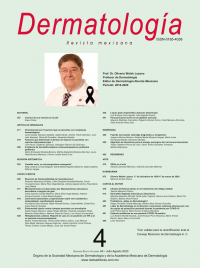Necrotizing fasciitis. Diagnostic and therapeutic approach.
Dermatol Rev Mex. 2020; 64 (4): 446-455.
Joaquín Moreno-Moreno,1 Adriana Mariel Muzquiz-Vargas,2 María Luisa Hernández-Medel,1 Alexandro Bonifaz3
1 Servicio de Infectología.
2 Servicio de Radiología.
3 Servicio de Micología.
Hospital General de México Dr. Eduardo Liceaga, Ciudad de México.
Resumen
La fascitis necrosante es una infección rápidamente progresiva que afecta la piel, el tejido celular subcutáneo, la fascia superficial y profunda. Es una enfermedad con alta mortalidad, es más frecuente en hombres y en 70% de los casos afecta las extremidades. Los principales factores de riesgo son la diabetes mellitus y la insuficiencia venosa y los microorganismos aislados con más frecuencia son Streptococcus pyogenes y Staphylococcus aureus. Las manifestaciones incluyen: edema, eritema, necrosis cutánea y anestesia cutánea. El diagnóstico es clínico, puede apoyarse del ultrasonido, la tomografía computada, la resonancia magnética o la exploración quirúrgica. El tratamiento inicial debe ser quirúrgico para el control del foco infeccioso asociado con antimicrobiano de acuerdo con la sospecha del agente causal.
PALABRAS CLAVE: Fascitis necrosante; Streptococcus pyogenes; Staphylococcus aureus.
Abstract
Necrotizing fasciitis is a rapidly progressive infection that affects the skin, subcutaneous cell tissue, superficial and deep fascia. It is a disease with high mortality, it is more frequent in men and in 70% of cases affects the extremities. The main risk factors are diabetes mellitus and venous insufficiency and the most frequently isolated microorganisms are Streptococcus pyogenes and Staphylococcus aureus. The clinical manifestations include: edema, erythema, skin necrosis and skin anesthesia. The diagnosis is clinical, it can be supported by ultrasound, computed tomography, magnetic resonance or surgical exploration. The initial treatment should be surgical to control the infectious focus associated with antimicrobial in accordance with the suspicion of the causative agent.
KEYWORDS: Necrotizing fasciitis; Streptococcus pyogenes; Staphylococcus aureus.

